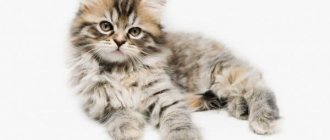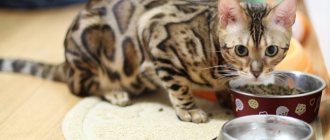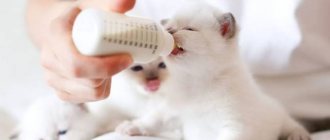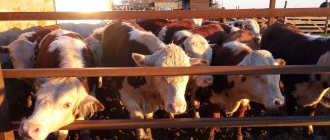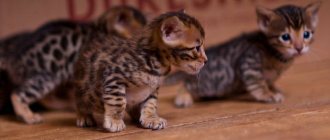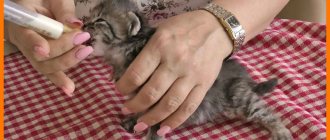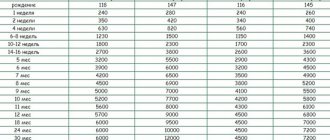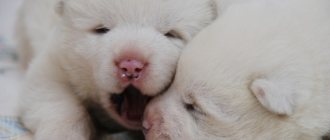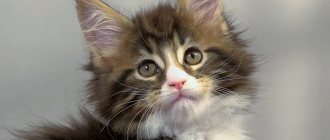Bengal cat: breed description, size and weight
Wild leopard cats combine the predatory grace and gentle nature of an ordinary pet.
The work of breeders makes it possible to keep the animal at home, without suffering either the animal or the owner. Bengals are notable for their loyal nature and love of play. They are suitable for a large family, where they can receive special attention. This breed is endowed with a strong, large body and sinewy paws. Therefore, the standard sizes and weight of a Bengal cat differ in many ways from other breeds.
Small domestic leopards can be recognized by the following standards:
- neat wedge-shaped head;
- eyes are set wide apart and can be of any shade (blue only with white color);
- small, rounded ears;
- powerful, short neck of equal width with transition zones;
- large bones and elongated hind legs;
- the front paws are particularly dexterous (can carry objects);
- a dense tail of medium length, tapering at a black tip.
The main feature of Bengals is their color and coat structure. Short but dense shiny hairs give the coat a rich look and make it pleasant to the touch . Long hair in this breed is rejected.
Exotic spots on the body indicate wild genes. Bengal cat kittens may lose them for a while as they grow up (up to a year). This phenomenon is absolutely normal and is not a defect.
The main colors include:
- spotted, characterized by small spots randomly scattered throughout the body;
- rosette, combining spots of various sizes and stripes extending from them;
- marbled, practically or completely eliminating spotting.
There is a silver snow bengal that can have any of the above colors.
Domestic Bengals have impressive sizes: males can reach 8 kg, females – 5-6 kg. The total length of the body is approximately 90 cm, and the height at the withers is 41 cm.
Bengal kittens grow quickly. By the end of the first week, they become 2 times larger than the parameters obtained at birth.
The size and weight of a Bengal cat depend on the parents involved in creating the offspring. Approximate indicators of kitten development by month can be found in the table:
Age (month)
Weight, kg)
The following points are worth remembering:
- initial weight changes over the course of a week;
- a one-month-old kitten should weigh about half a kilo;
- after 1 month of life and up to 3 months, growth is slow;
- when you step over 1 kilogram, growth will accelerate;
- a new slowdown will occur in the 7th – 9th month and will finally stop in females;
- males continue to increase their parameters up to 2 years.
If deviations from the norm are observed, it is worth consulting with a specialist and analyzing the animal’s nutrition.
The large weight and height of Bengal cats is already inherent in nature itself. In order for it to meet the standards throughout life, you need to follow some rules.
Proper care of Bengal kittens:
- The kitten's weight must be recorded every day. This will help track how many grams he has gained. Fourteen days after birth, you can no longer monitor your weight so often; once every 3 days is enough.
- If kittens that have not been weaned from the cat slowly gain weight, you should pay attention to the mother’s diet. It must be of high quality and balanced. For normal weight gain in kittens, it is necessary to add more protein and vitamins to the cat’s menu.
- If this measure does not produce results, the kitten should be shown to a specialist to rule out the presence of diseases.
- If the baby loses weight, you can feed it with industrially produced compounds specially designed for kittens of this breed.
Causes of weight loss in adulthood:
- Changing your diet. A Bengal may not like new food. It is recommended to choose food of the same brand. If the cat is on a natural diet, each new product should be introduced gradually, in small quantities.
- Parasites can cause your cat to lose weight. It is imperative to prevent infection with worms and fleas.
- Weight loss can be a consequence of any disease. If changing the menu and treating for worms does not help, you need to consult a veterinarian.
Where to buy, price
Bengal kittens should only be purchased from official nurseries; this will protect you from many troubles. If you make a purchase from dubious breeders, then there is a chance of purchasing a sick or purebred animal. When purchasing, you must check the pedigree and vaccination records.
The thing is that Bengal cat kittens up to 6 months old do not look at all like adults, but like the simplest yard “Vaskas” and “Murkas” and they can slip you an outbred animal that is simply similar in color. Prices for Bengal cats are very high and range from 35,000 to 50,000 rubles
. It all depends on the pedigree, color and class of the cat. The most expensive animals are show-class kittens. Fluffy babies from random mating can be bought for 10,000-12,000 rubles, but no one here can guarantee good health and high qualities of the breed.
No matter what color your pet is, Bengals always attract the attention of others. These are kind, strong and smart cats that will become your faithful and devoted friends. Good luck to you and your furry friend!
Briefly about the breed.
The most important feature of Bengal cats is their color, which is very similar to leopard print. Weight is close to that of a normal domestic cat. But having long legs makes a difference. Domestic cats are easily inferior to Bengals in this regard. The length of the cat is approximately 0.5-1.0 meters. Weight also has almost no restrictions and ranges from 3 to 7 kg on average. The breed takes root equally well in the desert and forests.
The nature of the animals is quite peaceful and flexible. Some habits resemble the habits of a dog. For example, a Bengal will have no problem bringing a toy thrown into the distance; he likes to hide things that are important to him, just as a dog hides bones far away for a treat if food is tight.
The cat tries to live peacefully with all family members, but considers one to be the owner. As a rule, the one who enjoys authority with the animal. Like most cats, it can also be mischievous - tear something to shreds, make loud noises during its displeasure or hunger. And the voice, by the way, is very different from the meowing of an ordinary cat. Scientists have accurately determined that the Bengal cat's voice is much louder.
The animals are very similar in color to tigers. Yellow color has a wide spectrum, depending on the habitat. A pale yellow tint is possible; there are also bright yellow inclusions; individuals with a red-yellow color are less common. These cats look special; the color scheme gives them some exoticism. Often yellowness is the main background against which a pattern of dark colors appears in the form of rosettes or solid spots. Dark horizontal stripes are visible on the neck and back of these cats.
Puberty
Due to the fact that Bengals' ancestors are wild cats, their instinct to reproduce is stronger than usual. Puberty can begin as early as 6 months of age. And along with this all the ensuing processes and behavior. Therefore, we recommend that you weigh the pros and cons in advance and decide on the future fate of the kitten.
If breeding offspring is not your main goal, then we recommend that you carefully study the issue of castration or sterilization. In this way, you will protect your home, your nerves and keep your pet healthy.
If you decide otherwise, then approach this issue thoroughly. Breeding Bengal cats is a rather complex process that has its own rules. One of the main ones is mating exclusively within the breed and with a healthy partner. Otherwise, you risk the appearance of mixed breeds with hereditary diseases. Some breeders are not eager to share their experience in this matter. Here a specialist felinologist can help you, who will examine your animal and give an appropriate conclusion. The felinologist of the club where you will register your pet can recommend candidates for procreation.
Cat size and weight
By the age of 2, the cat’s true height and weight are formed. Kittens are not much different from kittens of other domestic breeds in weight and size. Adult representatives of this breed look very respectable compared to an ordinary cat.
On average, their weight ranges from 4.5 kg to 7 kg. Cats are much heavier than cats. The difference in height is determined by the presence of long legs in the breed. At 2 years old, their height is statistically an average of 25 cm, then it can exceed 32 cm. Significant deviations from such norms call into question the presence of a breed in a particular individual.
Differences between wild and domestic cats. Bengals were a wild cat. Now there is every reason to consider them a domestic breed. However, it is still possible to discern differences between them. If we take into account the pet’s temperament, then owners are not recommended to have Bengal cats when there is a child under 5–7 years old in the house. That same wildness will manifest itself in impatience while tugging at the cat's tail. At this time, the animal will most likely fight back against its “tormentor”, and this can be uncontrollable and turn out tragically
The appearance reveals itself immediately by its color, and only then by its size and weight. The ears, for example, of these cats are small, short, and pointed upward. The tail is much thicker than that of domestic cats, as is the neck. The pads on the paws are more pronounced, perhaps this is one of the reasons for their speed and grace. Probably, the pads act as shock absorbers and it is easier for such cats to move through trees and overcome obstacles.
The cat's color is characterized by bright colors and sharp color transitions. Blurry, smoky patterns on the body of a certain cat do not place it in a row with a purebred cat - a Bengal. The tail is striped, often black and orange at intervals. The clearer the pattern and the brighter the colors, the more beautiful and respectable the animal appears.
The procedures for keeping a cat in excellent shape are not much different from caring for a domestic cat. The fur, however, is so smooth that it does not require the owner to spend a lot of time combing.
Once a week is quite a sufficient frequency for such a procedure. Nails should be cut once a week. It happens, however, when in the summer a cat ends up on the street (at the dacha, in a private house). Then you don't need to get rid of sharp claws. They really help you climb trees.
The real Internet star is a cat named Thor. Photos of him, without exaggeration, blew up social networks. A lot of comments and thousands of views determined the desire of many cat lovers to purchase a cat of this particular breed. It is so rare when wildness is perfectly combined with aristocracy.
Thor is an ideal representative of the breed with all its characteristics. The cat’s owner even admits that he is the one who feels in the power of his pet, the animal’s character is so powerful. The character of the cat. Briefly describing the character of the pet, we note that Bengals easily bypass the wildness inherent in their genes, cohabiting well with both people and dogs and many other domestic animals.
Weight standard
To be sure that your pet is growing and developing harmoniously, you can check the weight chart that is relevant for this breed. The standard provides for the body weight of a newborn kitten for a boy to be in the range of 70-140 g, for a girl - from 60 to 140 g. In the first week, these parameters are 40-260 g and 110-250 g, respectively, in two weeks - 340-400 and 150-360 g, at three weeks – 400–630 and 210–420 g, at four weeks – 550–740 and 250–600 g.
A two-month-old male weighs 1–1.7 kg, a female – from 450 to 900 g. A three-month-old pet should gain 1.5–2.5 kg, and a girl – 1–1.5 kg. A four-month-old boy weighs from 2.1 to 3.9 kg, and a girl weighs 1.7–2.4 kg. At five months, a cat weighs 2.6–4.3 kg, and a female cat weighs 2.2–2.9 kg. Body weight at six months is prescribed in the range of 3–5.4 kg and 2.3–3.6 kg, respectively, at seven months – 3.3–5.6 and 2.4–3.9 kg, at eight months – 3 .5–6 and 2.5–4.1 kg, at nine months – 3.8–6.4 and 2.5–4.3 kg, at ten months – 4.1–6.7 and 2.5 –4.4 kg, at eleven months – 4.3–6.8 and 2.5–4.5 kg.
At 1 year, the male has a body weight in the range of 4.5–7 kg, and the female – from 2.5 to 4.6 kg. The standard provides for the weight of a British cat, which is determined by one year of age, to be in the range of 2.5–5.5 kg, while an adult male reaches 4.5–8 kg. For castrated and sterilized animals, the parameters are different: the weight of a male is 4.5–9.5 kg, and that of a female is from 2.5 to 6 kg.
Briefly about the breed
The Bengal cat is a broad-shouldered and muscular pet with a short-haired spotted or merle pattern.
The head of the Bengal is pointed, the neck is short and powerful, and the tail is of medium length.
The Bengal cat is a broad-shouldered and muscular pet.
The color of the cats resembles their leopard ancestors. The color range varies within brown shades. There are also snow and silver Bengals.
Overweight or underweight
It is best to weigh babies at the same time to eliminate errors in determining body weight. Typically, a healthy pet becomes 100 g heavier every week. With a well-designed diet, problems should not arise.
But if, according to the data of the personal diary and the standards of the tablet, it is noticeable that body weight exceeds the norm or is significantly less, the diet should be adjusted. Sometimes kittens experience a short-term stabilization of weight indicators, after which proper weight gain resumes. In rare cases, consultation with a veterinarian may be necessary.
Why monitor the development of newborn kittens?
The weight of kittens is an indicator of their health.
Kittens can lose weight for the following reasons:
- congenital and acquired diseases;
- parasite infection;
- improper diet;
- breed or genetic abnormalities.
In order to timely identify deviations from the norm of nutrition and possible diseases, the owner of a Bengal cat is recommended to compare the kitten’s weight with the norms daily during the first weeks of life. In the future, the frequency of weighing can be reduced to 2 times a week.
Care and feeding of Bengals
A short-haired cat brings less worries at home than its long-haired counterparts, which makes caring for your pet much easier. Keeping and caring for a cat is not difficult: 2-3 times a week, devote a little time to combing the fur, which a soft rubber brush will help with. Sometimes you may not even notice the shedding, but once the procedure has begun, it is better to comb the kitty more often.
The descendant of a wild leopard cat needs to trim its claws once every couple of weeks. The ears are cleaned at the same intervals with a damp cotton pad.
It is also necessary to take care of your pet's oral cavity by brushing its teeth once a week.
The bath easily becomes a favorite place for the Bengal, who happily hits the water with his paws. Washing is allowed in rare cases using special cat shampoos.
Feeding a Bengal kitten occurs from month to month according to the feeding schedule and recommendations of specialists. Good nutrition quickly turns a small cat into a healthy, strong cat.
What to feed a Bengal kitten for 2 months
They also feed raw meat (beef or rabbit), exclude raw offal from the diet, replacing them with boiled sea fish once a week. Dairy products in the form of kefir, baby cottage cheese without any additives, and low-fat cream are useful for cats. The daily food intake also involves the addition of vegetables not exceeding a quarter of the volume of meat products. These are carrots, tomatoes, bell peppers. A Bengal cat can be switched to premium and super premium dry food, which the animals eat with benefit and pleasure.
Keeping a neutered cat involves replacing natural nutrition with specialized food.
Kitten weight table by age
The weight of a cat at each age should correspond to the norm:
| Age | Average breed weight |
| First week of life | 0.07-0.12 kg |
| 1 month | 0.4-0.5 kg |
| 2-3 months | 0.5-2.4 kg |
| 4-5 months | 2.7-3.6 kg |
| 5-6 months | 2.9-3.9 kg |
| 7 months | 4 kg |
| 8-9 months | 4.1-6 kg |
| 10 months - 1 year | 4.2-6 kg |
How do Bengals develop?
| Days, months | Events, activities |
| 5-8 days | The ear canal opens |
| 7-12 days | Eyes open |
| 12-21 days | The first teeth appear |
| 13-16 days | Ability to navigate by sound |
| from 14 days | Vision becomes clearer |
| from 18 days | First claw trimming Ability to stand on paws |
| 21-30 days | Learn to walk ; Fang trimming and deworming if necessary |
| from 30 days | Start of complementary feeding, toilet training |
| 5-10 weeks | Routine prevention of helminths Immunity borrowed from the mother weakens |
| 6-16 week | Vaccination |
| 8-12 week | Revaccination |
| 3 months | Moving to a new home |
| 12-14 week | Permanent teeth appear, immunity decreases |
| 3.5-7 months. | Routine vaccination |
| 6 months | Puberty |
| 4-20 months | Sterilization, castration |
“Gaining excess weight is not common in Bengal kittens, but if it happens, you should contact your veterinarian.”
Growth characteristics of Bengal kittens
Bengal kittens are born weighing from 70 to 120 g. By the first week of life, their weight doubles, and by the end of the month it reaches approximately 500 g. At the end of the first month, the process of weight gain gradually slows down.
Bengal kittens are born weighing from 70 to 120 g.
By 7-9 months, cats stop gaining weight, and cats continue to grow slowly until they are 2 years old.
According to the standards set by the World Cat Federation (WCF), the weight of a female should be 5 kg, and a male should be 8 kg. Body length varies from half a meter to 90 cm.
The weight of representatives of this breed largely depends on the genetic characteristics of the parents and can often exceed the average.
How much should a cat weigh at different stages?
Chihuahua weight by month and week: table
During the first 15–20 days of life, kittens spend most of their time sleeping. After about 16 days from the moment of birth, babies begin to be interested in the events happening around them, frolic and play.
The table shows the weight of a growing kitten by month:
| Kitten age | Kitten weight by month | Note |
| 1st day of life | Approximately 99 g | Average weight of a newborn kitten |
| 7th day of life | 149 g | If a 7-day-old kitten weighs less than 99 g, he is either seriously ill or malnourished. |
| 14th day of life (0.5 months) | 170 g | The weight of a kitten is given, which is not sick with serious illnesses, but also does not receive the maximum portion of attention. |
| 21 days of life (0.7 months) | 225 g | With special care, kittens reach the specified weight at the age of 14 days |
| 35th day of life (1.2 months) | 450 g | The weight of an absolutely healthy, naturally strong kitten is indicated. |
| 2 months from the date of birth | 900 g | The cat no longer feeds her kittens; their future fate depends entirely on the owner. The permissible minimum weight at this age is 710 g |
| 3 months | 1400 g | The average weight of a typical kitten is indicated. |
| 4 months | 1800 g | Average weight |
| 5 months | 2300 - 2900 g | Male kittens weigh more than their sisters |
The table shows the average weight. The exact indicators depend on the breed, gender and health status of the kitten.
Outbred kittens develop in approximately the same way as purebred kittens, only their mortality rate is higher due to the lack of additional nutrition.
A weak kitten weighs very little from the first days of life
Note! An animal that at the time of birth weighed less than its littermates will not be able to do without additional nutrition. Pushed away from his mother's nipples by stronger brothers and sisters, he does not receive enough nutrition, does not gain weight and becomes weaker.
Kittens stop needing mother's milk within a month after birth. By this time, their fangs and incisors have erupted, their ears take a vertical position (in representatives of straight-eared breeds), and their weight reaches 440-470 g. A kitten that has reached six months of age is considered an adult and weighs about 3 kg.
How to Help Your Bengal Kitten Gain Maximum Weight
To control the development of the Bengal, you should follow simple rules:
- During the first two weeks of life, monitor the kitten's weight daily. Then the procedure can be carried out 2 times a week.
- Provide your nursing cat with high-quality and balanced nutrition. If kittens on natural feeding do not gain weight well, then the amount of proteins and vitamins in the cat’s diet should be increased.
- If a kitten loses weight, it is recommended to feed it with special food for kittens.
Rules for weighing kittens
Kittens must be weighed every day. If they look healthy, once is enough. Sick newborns, as well as those whose weight at birth was less than 80 g, are weighed twice a day. The weakest and most disease-prone babies are usually born in large litters (5 or more kittens).
Important! Experts recommend weighing them at the same time to get the best idea of newborns' rate of weight gain. Without this, the breeder will not be able to determine the amount of additional nutrition. Overfeeding kittens is no less difficult than underfeeding.
During the weighing session, the mother cat must be kept near the kittens so that she can see what is happening with her children. Excessive worry can negatively affect the quality of mother's milk. To create the most accurate picture of kittens growing up, experts advise:
- Mark identical kittens with different colored food dyes. This will make it easier to identify them. The tags will have to be periodically updated, since the cat, licking the babies, will wash them off;
- use electronic kitchen scales as the most accurate;
- record weighing results.
What to do if your Bengal begins to gain weight poorly
Having noticed deviations in weight gain, you should determine the reasons for this.
Bengals are one of the cat breeds that lead an active lifestyle.
A few common reasons:
- Poor nutrition. Underweight occurs if the kitten is malnourished or does not receive enough nutritional components. Make sure that the kitten eats 6 times a day and has constant access to clean drinking water.
- Refusal to eat. This problem especially often occurs among owners who purchased a kitten from a breeder. The pet may already be accustomed to a certain food and refuse to eat a new one. In this case, you should transfer the kitten to a new food gradually.
- Stress. Sudden changes in environment and other factors can provoke stress. When stressed, kittens may refuse to eat. As a rule, adaptation takes from a couple of days to a week, after which the pet begins to eat normally and gain weight again.
- Diseases. If a Bengal eats properly, but still does not gain weight well, this may indicate diseases of the digestive system. In this case, you should definitely show your pet to a veterinarian.
- Parasites. Weight loss may indicate the presence of worms. Prevention against parasites should be carried out every six months starting from three weeks of age. For kittens, a suspension is used: it is easier to administer into the body.
Why you can’t pick up a kitten early
The desire to take a new pet home as soon as possible is understandable, but pursuing it is dangerous. Yes, there are irresponsible sellers who are ready to give an eight-month-old kitten to a new owner, but a responsible breeder will never allow him to be taken away from his mother and brothers and sisters so early.
From six to twelve weeks of age, the kitten continues to develop mentally, emotionally, physiologically and psychologically. For normal development, he needs to stay with his mother and other kittens. Early weaning will cause stress, which can significantly worsen your pet's condition.
The kitten’s immunity at this stage is very vulnerable, since the innate “margin of safety” has already been depleted, and the ability to resist diseases after the first vaccination is still developing. In a nursery, the likelihood of encountering new diseases is minimal, but it increases when moving to a new home.
Colds and bowel problems are especially dangerous at this time. Vaccination and the formation of new immunity under familiar conditions protect well against possible diseases. The kitten is not yet physically strong; the stress of moving often turns out to be an excessive burden on a weak body.
The transition from breastfeeding to solid food occurs gradually. At eight weeks, the kitten is still at the beginning of this journey. By the twelfth week he is completely ready to eat ready-made food. It is the mother cat who teaches the kitten to cope with the disappointment of lack of milk. She is nearby, ready to caress him. The stress on the psyche is reduced, and the risk of behavioral problems in the future is minimal. The breeder accustoms the kitten to being held.
Digestion will be much better if the new owner follows the breeder's recommendations for feeding the pet. Switching to a new type of diet can cause diarrhea. Diarrhea causes dehydration and poses a danger to your pet. Breeders always know how to take care of a kitten in such a situation, but new owners almost never do. The ability to use a litter tray develops around 10-12 weeks. A two month old kitten is too young to learn this skill.
“Keeping a purebred kitten for an extra month is not cheap. If the seller willingly gives away a pet at two months, he is more interested in profit than in the successful development of the little Bengal. It’s better to refuse a dubious deal and turn to a breeder with a good reputation.”
A kitten without documents, but with a similar color, may cost less than that of a breeder, but it may not even be a Bengal, but a hybrid from a random mating. His health, upbringing and ability to learn are in big question. A well-mannered Bengal cat is not aggressive. He can be trained to use a regular toilet; he understands that a person’s arms and legs are not a toy.
Do not be afraid that at three months a kitten is less affectionate than at eight weeks. On the contrary, the stress of early relocation and separation from mother, illnesses that are almost certain to occur, can make adaptation difficult. A healthy and developed pet has the strength and opportunity to calmly explore a new place and fall in love with its new family.
If there are other animals in the house, socializing the cat before 12-14 weeks is even more important. During this period, the kitten acquires communication skills with other kittens and adults. The ability to calmly communicate with people and not be afraid of them is also formed at this time. The correct timing for moving eliminates problems for both the owner and the little Bengal.
The new owner can learn a lot of useful information from the breeder: what to feed, how to properly care for them, trim their nails and wean them off bad habits if they appear, how to distinguish the first signs of illness, calm them down, clean their ears, when to vaccinate, etc. It should be remembered that runners always live in an apartment and need space to play. A kitten worth several tens of thousands of rubles should not walk on its own. A curious and active pet can run away in just a minute.
Purchase. How to choose the right Bengal kitten
A huge role in the health of a kitten is played by its pedigree. You shouldn't expect a large pet from oversized parents.
It should also be taken into account that if the parents are quite large in size, and the kitten does not meet the weight standards for its age, then, presumably, it is from a large litter.
In the womb and during natural feeding, kittens from a large litter may not have received enough vitamins and other useful substances, therefore, there is a risk that their health will be poor.
A huge role in a kitten’s health is played by its pedigree.
When buying kittens, they examine the eyes and inner surface of the ear:
- Eyes should be clean, without signs of conjunctivitis. The eye color of a Bengal kitten is fixed by the age of 1.5-2 years. Until this age, the color may change from yellowish to green and blue. According to the standard, the Snow Bengal must have blue eyes.
- The inner surface of the ear should be clean; inflammation may indicate the presence of ear mites.
The kitten's color may seem uncharacteristic of the breed, but this is normal.
Bengals acquire their adult coloration when they reach two months of age.
You should not buy a Bengal from your own hands: there is a risk of purchasing a sick animal with deviations from breed standards.
Diseases and how to avoid them
Despite the fact that the breed was developed by crossing species, it has good health. However, Bengal cats are predisposed to certain diseases:
- "Dry nose syndrome." It appears in kittens up to one year old in the form of a dry crust on the nose. Examine your pet more often and take it to a specialist on time.
- Another early age disease is flat chest syndrome. This is caused by the incompatibility of some genes of different species, as a result of which the organs cannot grow in the required volume and the animal dies. This has been recorded at the age of up to 3 weeks.
- Heart disease, or the scientific term "hypertrophic cardiomyopathy", refers to genetic diseases. Only a specialist can identify it.
- Leukemia, a blood cancer in animals, is also a hereditary disease. You can be careful by checking the documents of parents of several generations.
- Most often, representatives of the breed suffer from indigestion and poisoning. This is caused by a weak stomach and intestines. Therefore, it is very important to choose the right food for your Bengal. If you notice a loss of appetite, a lethargic appearance, an increased body temperature, and pressing on the stomach is painful - these are the first signs of intestinal inflammation. Go to the vet immediately and do not self-medicate.
Size and weight of Bengals: differences between cats and Bengal cats
The breed of domestic cats with the color of a wild leopard is endowed with a naturally strong and large body, sinewy paws with sharp claws of a forest predator, and powerful jaws. Therefore, the standard sizes, as well as the weight of Bengal cats and cats, differ in many ways from the parameters of other types of domesticated representatives of the cat family in the world. At the same time, Bengals combine predatory grace and, thanks to the work of breeders, the friendly and affectionate nature of a pet. This allows you to successfully keep the breed in normal home conditions, without causing inconvenience to the animal, owner or household members. During the breeding and development of the breed, the main emphasis of the author of the unique project J. Millan was on the external similarity of domestic Bengals with their Asian forest ancestors. In the description of the appearance of Bengals, in addition to the famous spotted color and fur with glitter (shine like sparklers), it is indicated that they are quite muscular cats with strong bones, distinguished by the ability to jump high, climb objects with agile movements, and attack with lightning speed from an ambush.
Character
Despite the fact that the Bengal breed has 20% “wild blood”, its character is affectionate and playful, but not aggressive. It is great for cohabitation with other animals and even dogs; it is not uncommon for a Bengal cat and a dog to become best friends. For children, this is generally a godsend: the cat is very patient, flexible and has high intelligence. Thanks to this, she is easy to train and responds well to training. With the right approach, it will not be difficult to accustom your cat to the toilet.
The character of Bengal cats is somewhat similar to dogs, it is not for nothing that they are called “cat-dogs”. They are active and energetic throughout their lives and age is not a hindrance to this. They love to play with all kinds of toys and splash in the water. A distinctive feature is the manner of communication with a person, which manifests itself in various intonations and sounds. She seems to be talking to you, and sometimes even responds to your comments about her.
And yet, the habits of a wild leopard make themselves felt: the cat has a persistent temperament and a love of freedom. Don't be surprised if your pet doesn't always want to sit in your arms. It must be remembered that the wild Bengal was socialized. Therefore, she does not tolerate loneliness well and may harbor resentment.
What determines the size and weight of Bengals?
Domestic Bengal cats owe their physical characteristics to wild, not so distant ancestors. The size of the spotted animals, called leopard cats (Prionailurus (Felis) bengalensis, abureviation ALC), approximately corresponds to the size of ordinary pets of other breeds. However, the legs are longer, and the hind legs are noticeably higher than the front ones. The external parameters of Felis bengalensis vary greatly depending on the habitat. Thus, the smallest, weighing an average of 2.5 kg, live in the Philippines, and the largest Ussuri, weighing up to 10 kilograms, live in the Russian taiga.
Accordingly, both the height and body length of Bengal cats fluctuate greatly in nature. The largest individuals can reach 95 centimeters with their tail.
When characterizing the physical characteristics of Bengals, we must not forget that their breeding involved not only species of wild cats from the subfamily of small cats, but also a whole list of representatives of other breeds. So, how big a Bengal cat grows depends on a number of factors. However, existing weight tables, which were derived as a result of many years of observations, still help to track the correctness of how much a representative of the breed should weigh at a particular age.
Dynamics of weight gain in Bengal kittens
Kittens in a Bengal litter grow quickly. Already by the beginning of the second week of life, a Bengal kitten becomes 2 times larger than those parameters recorded at birth, and this weight ranges from 70 to 120 grams. Of course, the size and body weight of a Bengal kitten depend on the physical characteristics of its parents. Approximate indicators of correct development by month are as follows:
- end of the first week: up to 250 grams;
- end of the first month of life (four or five weeks): from 400 to 500 grams;
- 3 months - about a kilogram;
– 7 months – 4 kilograms;
– 10-12 months – 4.2 – 6 kg.
The weight gain algorithm is uneven, there are the following features:
- a kitten’s growth at 2 months is much slower than before;
— having crossed the figure of 1 kilogram, growth accelerates significantly;
- at 7-9 months there is a new slowdown in weight gain, and female Bengals actively stop growing, and males continue to increase their parameters up to 2 years.
If the owner of a Bengal kitten experiences significant deviations from the norm towards lower weight, it is worth analyzing the diet of the mother (the menu of a nursing cat should contain more protein, calcium, vitamins) and the animal itself, and consult with a specialist.
The opposite situation may also be true: a kitten at 4 months has become fat, having gained the maximum weight expected for it at six months or even at 1 year. In this case, you will also need the help of a veterinarian.
Standards for weight and size of adult Bengal cats and cats
Domestic Bengals have impressive sizes as adults: males of the breed can reach 8 kg, and females - 6 kg. The height of a large animal at the withers is 40 cm, and the total length of the body with a tail is approximately 90 cm. The elongated body with amazing flexibility makes representatives of the Bengal breed graceful, which is one of the differences from other purebred pets from the cat family.
Naturally, females differ from males in their appearance and physical characteristics. The difference in weight, and, accordingly, in other parameters, is immediately noticeable. A junior cat that has reached sexual maturity, which is 8-9 months, is almost twice the size of a cat. Its paws and tail are more powerful.
Taking into account the goal - to create a pet that has the external and physical characteristics of small animals living in their natural environment, special standards were developed for the breed. The jury of exhibitions, championships and competitions takes into account, in particular, how athletic the animal is, how it holds its thick tail, the length of which should be average, what the size of the nose, ears and especially convex pads under the whiskers of this breed are.
Possible assumptions
Some felinological associations consider the following physical deviations from the ideal representative of the Bengal breed to be unimportant:
- smaller size of the cat while maintaining overall harmonious proportions (this assumption does not apply to cats);
- the cat’s cheeks are slightly larger than those required by the strict standard;
- the shape of the eyes, which are supposed to be almost round, is visualized as slightly almond-shaped;
— the difference between the length of the animal’s front and hind legs is not very noticeable.
These shortcomings may not affect the decision to award the win to a male cat if all other main parameters are ideal.
History of the origin of the breed
The Bengal cat breed has been registered with the International Cat Association since 1983 under the name Bengal cat. Experiments on crossing wild Bengal cats with domestic species have been conducted since the 70s by the American breeder Jean Mill. Despite the great efforts put into breeding, the origin of the Bengal was associated with difficulties, since it was necessary to cross different species of animals.
The first results of the introduction of Far Eastern cat genes led to the appearance of kittens with poor health, but at the moment the domestic Bengal cat has excellent performance. Today there are a large number of varieties of this breed. The Bengal F1 is considered the most beautiful.
About the main reasons for weight loss in adult Bengal cats
Not only felinologists, breeders, but also ordinary cat lovers have probably heard about the delicate gastrointestinal tract of Bengal cats. Gradual or sudden weight loss can result from:
- change in diet - either the Bengal did not like the new food, or it caused rejection in his body;
- the animal has parasites - it is imperative to carry out prevention against infection with worms;
- the process was the result of some serious disease - to find out this, an examination by a veterinarian is necessary.
The large size of Bengal cats (although they are not the largest representatives of domestic pets) is inherent in nature itself. Weight and height depend, as in humans, on the parents of a particular individual, as well as on the quality of the animal’s maintenance. In order for a four-legged pet to meet all standards, it is necessary to verify the authenticity of its pedigree at the stage of choosing a kitten in the nursery.
What does weight depend on?
Male kittens weigh more than females as they grow up. With each new weighing, the difference increases. The weight of mature males and females is influenced by a number of factors.
Bengal cats
During the first week of life, the weight of a Bengal kitten can reach 250 g, and after another three weeks the baby will weigh from 400 to 500 g. A three-month-old teenager weighs about a kilogram.
A Bengal kitten reaches 1 kg at 3 months
Bengals are a fairly heavy breed, but they are never fat. Kittens are very active and energetic, they run a lot, they are always in excellent physical shape, although they look well-fed and even overfed. They owe their appearance to their natural muscularity.
Note! The weight of a Bengal kitten depends to the greatest extent on the development of its muscular system. We must not forget that Bengals are big-boned animals.
